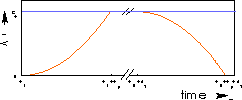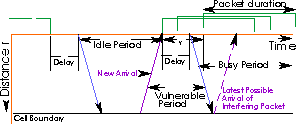
Propagation Delays in ISMA
In Inhibit Sense Multiple Access, the base station continuously broadcasts channel
status to terminals. This signalling leads to two types of delays:
- Delays due to the processing of the carrier sensing at the base station
- Power up delays
A new terminal may sense the channel during the power up interval of
another terminal that is starting a transmission. Power up is slow, typically it takes on the order of several bit times
to switch on a transmitter.
- Propagation delays
Because of finite speed of radio waves, the
feedback signal is received by a terminal only
after a distant-dependent delay.
Nearby terminals have up-to-date information, but
remote terminals have a more retarded view
of the channel status.
Hence, propagation delays lead to unfairness
Packet arrivals at the receiver
- Arrival process is not an on-off switched
Poisson process
- As the leading edge of the busy signal
propagates outward, more and more terminals
will be inhibited
- So, the packet arrival rate will decrease
gradually, rather than step-wise.

Figure: Non-stationary Poisson arrival rate seen by base station
The arrival rate (as depicted above) can be derived from studying
the wake signal propagation model discussed below.
'Wake' channel traffic model

Figure: Time - Space Diagram for signals travelling in ISMA network.
Vertical: distance, Horizontal: time.
Arrows pointing up: signal from terminal travelling to the base station
Arrows pointing down: Busy/Idle feedback signaling from base station travelling to all terminals
Green: Incoming packets as present at the base station receiver.
- 'idle period',
the terminal receives idle signal and a packet will
indeed arrive at an idle receiver.
Duration i(r) depends on location of the terminal.
- 'vulnerable period',
the terminal receives an idle signal, but a packet
transmitted is bound to arrive at a busy receiver.
Duration v(r)
- 'inhibited period',
period during which a busy signal is received.
Duration h does not depend on distance r.
- 'cycle',
period from beginning of inhibited period until
beginning of next inhibited period.
Duration a = h + i(r) + v(r).
Total delay in feedback
Delay consist of
- Fixed part, called 'processing delay',
- After receiving an initiating packet, the base
station starts transmitting a busy signal after d1.
- After the last of the colliding signals terminates,
the idle signal is transmitted with a delay d2.
- Distant-dependent part, called 'propagation
delay'.
Velocity of light is 3 10^+8 m/s
Example:
Bit rates 150 Mbit/s;
packets of 400 bits; cell size 80 meters
Propagation delay = 0.1 packet time
Probability of successful transmission
Depends on
- round trip delay to cell fringe
- d1 switching delay
- average duration of inhibited period
- I(r) average duration of idle period
The probability of successful access
is proportional to the duration of the idle period, so it
almost linearly decreases with increasing distance.
How to approximate effect of propagation delays?
Literature sometimes says that one can
-
consider all terminals to be at identical (worst-case)
distance to the base station and
- add the one-way propagation delay both to d1 and to d2.
This approximation is acceptable for CSMA. However, for ISMA it is optimistic, i.e., it overestimates throughput.
A better approximation for ISMA is to add the maximum round-trip (two way) delay to d1 and not to account for propagation delays in d2.







